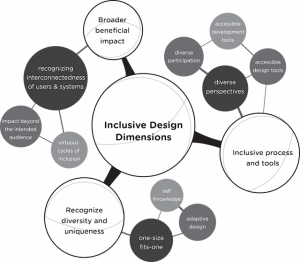Since everyone has a different learning style and preference, learners learn more efficiently when their experiences are personalized. Flexible Learning for Open Education(FLOE) provides the resources to meet the needs of comprehensive diversification of learners and the creation of personalized educational resources for learners.
Three concepts I think are most important
The first concept I think is most important is FLOE uses inclusive design for open learning. Inclusive design that considers the full range of human diversity with respect to ability, language, culture, gender, age and other forms of human difference.” (Inclusive Learning Design Handbook) Diverse learning experiences meet the learning needs of different learners and effectively solve their learning barriers. Inclusive design can recognize diversity and uniqueness. This kind of design can make every learner give full play to their potential, and this kind of design will have a very positive impact on society. If everyone can get a fair educational opportunity, society will become better and more prosperous.

Photo from inclusive design research center by OCAD University
The second concept is Video Content and Learning. I think watching videos is a good way for learning because videos contain both visual and audio contents which are pretty vivid for learners to learn knowledge. Moreover, people can pause and watch the parts they misunderstood many times, so the videos can catch every learner’s pace. Compared with long-term reading, video is more relaxing and interesting, helping students increase the interest of learning. And they can choose different learning videos online according to their own preferences

Photo from the article “A clip for Everything: Why Video Is Such a Powerful Learning Medium” by Johnathan316
The third concept is Accessible Standardized Testing. I think this kind of test is fair and applicable to everyone. There are different types of tests for different levels. Teachers can choose different test types according to students’ needs and course contents. At the same time, this kind of test can set an appropriate test method for disabled people. The test designer can also consider many factors (such as colors, text sizes and audio etc.) in order to give students the best test format. Computer-delivered accessible standardized testing is the best way to reduce accidents and special arrangements.

Photo from NWEA Testing Resources 2019 by Mr.Toledo
Two concepts I am having difficulty understanding
The first concept is SVG and Accessibility. Although the Inclusive Learning Design Handbook provides the definition of SVG which is “describing vector graphics in markup on a web page”(Inclusive Learning Design Handbook), I think this concept is really complex to me. I don’t understand how it works efficiently with inclusive design. I think this concept is too advanced to me I must master computer science in order to understand this idea.
The second concept is Accessible Modal Dialogs.“A modal dialog is an interaction where the user is forced to take an action required before proceeding to another activity.”(Inclusive Learning Design Handbook) I am confused with the correlation with this concept, FLOE and how it helps to learn to use the OER. I think there are better ways to keep the interaction simple, such as providing discussion forums inside the website or chatting applications for learners and instructors.
One question in relation to universal design
Is there any way for learners to identify which OER is best for them to identify the effectiveness of information appeared in online courses?
Reference
Inclusive Learning Design Handbook from OCAD University. https://via.hypothes.is/https:/handbook.floeproject.org/
Flexible learning for open education (FLOE) Project website. https://floeproject.org/